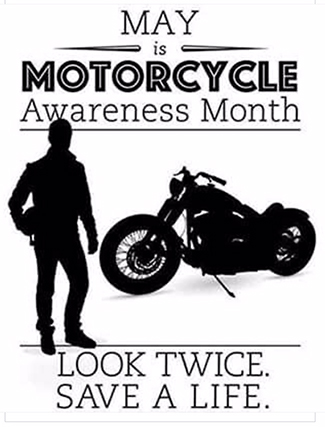KANSAS CITY — This May, the U.S. Department of Transportation’s National Highway Traffic Safety Administration (NHTSA) Region 7, which includes Arkansas, Iowa, Kansas, Missouri, and Nebraska, would like to remind all motorists that Motorcyclist Safety Is Everyone’s Safety.

May is Motorcycle Safety Awareness Month, and the end of May ushers in the unofficial start of the summer road-travel season. Safe riding and driving practices will help reduce the number of fatalities and injuries on our nation’s highways. It’s everyone’s responsibility — both the motor vehicle driver and the motorcyclist — to practice safe habits on the road and, ultimately, to Share the Road.
“There were 5,932 motorcyclists killed in traffic crashes in 2021, a 7.7 percent increase from 2020 (5,506),” said NHTSA Regional Administrator Susan DeCourcy. She continued, “Motorcyclist deaths accounted for 14 percent of the total highway fatalities in 2021 Sadly, motorcyclists are significantly overrepresented in traffic crashes and fatalities each year. In fact, motorcyclists were about 28 times more likely than passenger vehicle occupants to die in a motor vehicle crash and were 4 times more likely to be injured. We want to change that, and it starts with everyone on the road understanding that motorcyclist safety is everyone’s safety.”
One of the primary contributing factors to motorcyclist fatalities is speeding. According to NHTSA, 34 percent of all motorcycle riders involved (killed or survived) in fatal crashes in 2020 were speeding, compared to 22 percent for passenger car drivers, 16 percent for light-truck drivers, and 7 percent for large-truck drivers. Motorcycle riders 25 to 29 years old involved in fatal crashes had the highest speeding involvement at 45 percent.
Alcohol impairment also plays a significant role in motorcycle-involved crash fatalities: 41 percent of the 2,158 motorcycle riders who died in single-vehicle crashes in 2020 were alcohol-impaired. In 2020, motorcycle riders involved (killed or survived) in fatal crashes had higher percentages of alcohol impairment than any other type of motor vehicle driver (27 percent for motorcycle riders, 23 percent for passenger car drivers, 19 percent for light-truck drivers, and 3 percent for large-truck drivers), and those killed were almost three times more frequently found to be alcohol-impaired at night than during the day (40 percent and 14 percent, respectively).
Like seat belts, helmets are a simple and effective way to reduce the likelihood of injury or death during a crash. However, helmet use has declined from 69 percent in 2020 to 64.9 percent in 2021. In contrast, helmet use continues to improve in states that require all motorcyclists to be helmeted. Additionally, it’s important to understand that both motorcyclists and their passengers should always wear a helmet.
Among riders with passengers, helmet use among riders with passengers continued a sharp decrease at 52.1 percent in 2021, down from 65 percent in 2020 and 79.7 percent in 2019. In contrast, riders wearing DOT-compliant helmets saw their passengers’ helmet use increase significantly from 84.5 percent in 2020 to 91.1 percent in 2021.
Safe driving and riding practices by all road users — drivers and riders alike — will help reduce the number of fatalities and injuries on our nation’s highways. Motor vehicle drivers and motorcyclists should keep the following tips in mind when on the road:
- Observe all traffic laws and always obey the speed limit.
- Drive and ride alcohol- and drug-free.
- Avoid distractions that place other road users at risk.
- Yield to motorcyclists, especially while turning at intersections.
- Wear high-visibility personal protective gear and DOT-compliant motorcycle helmets. NHTSA data estimates that helmets saved 1,872 motorcyclists’ lives in 2017 and that 749 more lives could have been saved if all motorcyclists had worn their helmets. Learn how to identify a safe, DOT-compliant helmet at www.nhtsa.gov/motorcycle-safety/choose-right-motorcycle-helmet
This May, let’s commit to safe driving and riding, and to our role in ensuring a safe motorcycle-riding environment. To ensure a safer riding experience, NHTSA recommends that all riders complete a rider education and training course. For more information on motorcycle safety, visit www.nhtsa.gov/road-safety/motorcycles. For additional statistics please visit https://cdan.nhtsa.gov/ and search “motorcycle” under Crash Data Publications.
